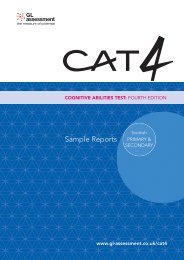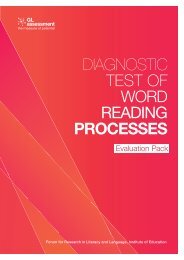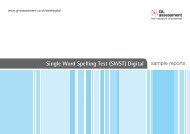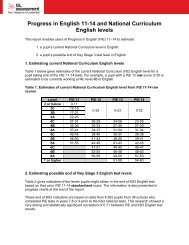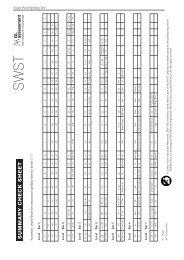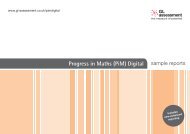BAS3 Parent Report Early Years - GL Assessment
BAS3 Parent Report Early Years - GL Assessment
BAS3 Parent Report Early Years - GL Assessment
- No tags were found...
You also want an ePaper? Increase the reach of your titles
YUMPU automatically turns print PDFs into web optimized ePapers that Google loves.
<strong>BAS3</strong> PARENT REPORT<br />
What do the <strong>BAS3</strong> results show?<br />
Your child completed the tests that were most suited to identifying her<br />
needs. The tests in the <strong>BAS3</strong> combine to produce different types of scores.<br />
A summary of these scores and the abilities they test is shown below.<br />
Type of<br />
score<br />
Verbal Ability<br />
Non‐verbal<br />
Reasoning Ability<br />
Spatial Ability<br />
General<br />
Conceptual Ability<br />
Special Non‐verbal<br />
Composite<br />
Measures your child’s ability to...<br />
Understand and use spoken words and language.<br />
Work out why numbers, pictures or patterns are<br />
linked with others.<br />
Remember and make sense of shapes and the way<br />
they are arranged.<br />
Use all three kinds of ability – verbal, spatial, nonverbal<br />
reasoning.<br />
This score summarises your child’s overall thinking<br />
and problem solving abilities.<br />
Use two kinds of ability – spatial and non‐verbal<br />
reasoning.<br />
This score is used when children are unable to do<br />
tests involving words, or when they would find such<br />
tests very difficult.<br />
How is the <strong>BAS3</strong> scored?<br />
The <strong>BAS3</strong> scores are presented in percentiles, showing your child’s rank<br />
when compared with what would be expected for 100 children of the same<br />
age. For example, if your child ranked in the 55 th percentile, it would mean<br />
that she scored higher than 55 out of 100 children of the same age.<br />
About two thirds of children will rank between the 16 th and 84 th percentile,<br />
so percentiles help us to decide how typical or unusual your child’s score is.<br />
Descriptions of the percentiles are provided below.<br />
Percentile<br />
Description<br />
1 st – 2 nd Very Low<br />
3 rd – 8 th Low<br />
9 th – 24 th Below Average<br />
25 th – 74 th Average<br />
75 th – 90 th Above Average<br />
91 st – 97 th High<br />
98 th – 99 th Very High<br />
© 2012 <strong>GL</strong> <strong>Assessment</strong> Limited<br />
Created on 27/03/2012 for A. Psychologist of Independent <strong>Assessment</strong> Services 3



